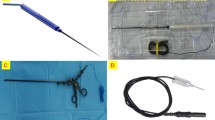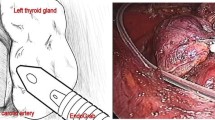Abstract
Introduction
The application of intraoperative neural monitoring (IONM) trouble-shooting algorithms procedures in transoral endoscopic thyroidectomy vestibular approach (TOETVA) was investigated.
Methods
Loss of signal (LOS) is defined as a loss of the primary electromyographic (EMG) normal biphasic waveform with reduced amplitude response to less than 100μV with a stimulation level intensity of 1–2mA. A systematic review of the IONM system at LOS was covered methodically: (i) correct endotracheal tube verification, (ii) stimulation of the recurrent laryngeal nerve (RLN) at entry point, (iii) ipsilateral or contralateral vagal nerve (VN) stimulation, and (iv) laryngeal twitch (LT).
Results
The function of 223 nerves at risk (NAR) was recorded with IONM. Twenty-seven (12%) NAR experienced a suspected LOS. LT could not be appreciated. In 15/27 (55%) cases, the application of the IONM trouble-shooting algorithm revealed upward displacement of the EMG tube (all orotracheal intubations). In 9 (4%) NAR, VN stimulation was not accomplished. In detail, there were n.5 left and n. 4 right VNs. Two VNs were ipsilateral, and 7 VNs contralateral. For EMG tube displacement, because the oral/nasal area is included in the aseptic field, it is less possible to re-check by the laryngoscope or fiberscope.
Conclusions
A limit for applying the IONM trouble-shooting algorithm to TOETVA is determined by (a) inability to appreciate the LT, (b) difficulty in stimulating the ipsilateral and contralateral VN, and (c) remodeling EMG endotracheal tube position. A modified IONM trouble-shooting algorithm for TOETVA is proposed.






Similar content being viewed by others
References
Anuwong A, Sasanakietkul T, Jitpratoom P, Ketwong K, Kim HY, Dionigi G, Richmon JD (2018 Jan) Transoral endoscopic thyroidectomy vestibular approach (TOETVA): indications, techniques and results. Surg Endosc 32(1):456–465. https://doi.org/10.1007/s00464-017-5705-8
Zhang D, Li S, Dionigi G, Wang T, Zhang J, Xue G, Sun H (2018 May 10) Feasibility of continuous intraoperative neural monitoring during transoral endoscopic thyroidectomy vestibular approach in a porcine model. J Laparoendosc Adv Surg Tech A 29:1592–1597. https://doi.org/10.1089/lap.2018.0054
Zhang D, Li S, Dionigi G, Zhang J, Wang T, Zhao Y, Xue G, Sun H (2019 Jun 19) Stimulating and dissecting instrument for transoral endoscopic thyroidectomy: proof of concept investigation. Surg Endosc 34:996–1005. https://doi.org/10.1007/s00464-019-06936-2
Witzel K, Benhidjeb T (2009) Monitoring of the recurrent laryngeal nerve in totally endoscopic thyroid surgery. Eur Surg Res 43(2):72–76
Inabnet WB 3rd, Suh H, Fernandez-Ranvier G (2017) Transoral endoscopic thyroidectomy vestibular approach with intraoperative nerve monitoring. Surg Endosc 31(7):3030
Wang Y, Yu X, Wang P, Miao C, Xie Q, Yan H, Zhao Q, Zhang M, Xiang C (2016) Implementation of intraoperative neuromonitoring for transoral endoscopic thyroid surgery: a preliminary report. J Laparoendosc Adv Surg Tech A 26(12):965–971
Dionigi G, Wu CW, Tufano RP, Rizzo AG, Anuwong A, Sun H, Carcoforo P, Antonino C, Portinari M, Kim HY (2018) Monitored transoral endoscopic thyroidectomy via long monopolar stimulation probe. J Vis Surg 4:24. https://doi.org/10.21037/jovs.2017.12.25 eCollection 2018
Zhang D, Mazzeo C, Dionigi G, Wu CW, Carcoforo P, Sun H, Materazzi G, Tufano RP, Kim HY (2019) Nerve monitoring for transoral thyroid surgery: why, how, and what to expect. Curr Otorhinolaryngol Rep 7:225–231. https://doi.org/10.1007/s40136-019-00251-z
Chen HK, Chen CL, Wen KS, Lin YF, Lin KY, Uen YH (2018 Jan) Application of transoral continuous intraoperative neuromonitoring in natural orifice transluminal endoscopic surgery for thyroid disease: a preliminary study. Surg Endosc 32(1):517–525
Randolph GW, Dralle H, International Intraoperative Monitoring Study Group, Abdullah H, Barczynski M, Bellantone R, Brauckhoff M, Carnaille B, Cherenko S, Chiang FY, Dionigi G, Finck C, Hartl D, Kamani D, Lorenz K, Miccolli P, Mihai R, Miyauchi A, Orloff L, Perrier N, Poveda MD, Romanchishen A, Serpell J, Sitges-Serra A, Sloan T, Van Slycke S, Snyder S, Takami H, Volpi E, Woodson G (2011) Electrophysiologic recurrent laryngeal nerve monitoring during thyroid and parathyroid surgery: international standards guideline statement. Laryngoscope 121:S1–S16
Randolph GW, Kobler JB, Wilkins J (2004) Recurrent laryngeal nerve identification and assessment during thyroid surgery: laryngeal palpation. World J Surg 2888:755–760
Schneider R, Lorenz K, Sekulla C, Machens A, Nguyen-Thanh P, Dralle H (2015 Feb) Surgical strategy during intended total thyroidectomy after loss of EMG signal on the first side of resection. Chirurg. 86(2):154–163
Chiang FY, Lu IC, Kuo WR, Lee KW, Chang NC, Wu CW (2008 Jun) The mechanism of recurrent laryngeal nerve injury during thyroid surgery--the application of intraoperative neuromonitoring. Surgery. 143(6):743–749
Dionigi G, Boni L, Rovera F, Rausei S, Castelnuovo P, Dionigi R (2010 Apr) Postoperative laryngoscopy in thyroid surgery: proper timing to detect recurrent laryngeal nerve injury. Langenbeck's Arch Surg 395(4):327–331. https://doi.org/10.1007/s00423-009-0581-x
Lu IC, Chang PY, Randolph GW, Chen HY, Tseng KY, Lin YC, Chiang FY, Wu CW (2018 Sep) Safety of high-current stimulation for intermittent intraoperative neural monitoring in thyroid surgery: a porcine model. Laryngoscope. 128(9):2206–2212. https://doi.org/10.1002/lary.27086
Barber SR, Liddy W, Kyriazidis N, Cinquepalmi M, Lin BM, Modi R, Patricio S, Kamani D, Belotti C, Mahamad S, Lawson B, Randolph GW (2017 Sep) Changes in electromyographic amplitudes but not latencies occur with endotracheal tube malpositioning during intraoperative monitoring for thyroid surgery: implications for guidelines. Laryngoscope. 127(9):2182–2188. https://doi.org/10.1002/lary.26392
Tsai CJ, Tseng KY, Wang FY, Lu IC, Wang HM, Wu CW, Chiang HC, Chiang FY (2011 Mar) Electromyographic endotracheal tube placement during thyroid surgery in neuromonitoring of recurrent laryngeal nerve. Kaohsiung J Med Sci 27(3):96–101. https://doi.org/10.1016/j.kjms.2010.08.002
Kim HY, Tufano RP, Randolph G, Barczyński M, Wu CW, Chiang FY, Liu X, Masuoka H, Miyauchi A, Park SY, Kwak HY, Lee HY, Dionigi G (2016) Korean Intraoperative Neural Monitoring Society (KINMoS). Impact of positional changes in neural monitoring endotracheal tube on amplitude and latency of electromyographic response in monitored thyroid surgery: results from the porcine experiment. Head Neck 38(Suppl 1):E1004–E1008. https://doi.org/10.1002/hed.24145
Author information
Authors and Affiliations
Contributions
All authors equally contributed to conception, design, manuscript writing, and final approval of manuscript.
Corresponding authors
Ethics declarations
Ethics approval and consent to participate
All procedures performed in studies involving human participants were in accordance with the ethical standards of the institutional and/or national research committee.
Consent to publish
Patients signed an informed consent before surgery for dataset use.
Conflict of interest
The authors declare no competing interests.
Additional information
Publisher’s note
Springer Nature remains neutral with regard to jurisdictional claims in published maps and institutional affiliations.
Level of evidence: NR
Rights and permissions
About this article
Cite this article
Zhang, D., Wu, CW., Wang, T. et al. Drawbacks of neural monitoring troubleshooting algorithms in transoral endoscopic thyroidectomy. Langenbecks Arch Surg 406, 2433–2440 (2021). https://doi.org/10.1007/s00423-021-02217-6
Received:
Accepted:
Published:
Issue Date:
DOI: https://doi.org/10.1007/s00423-021-02217-6




